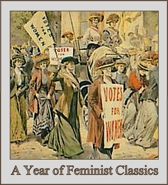Reviewed by Ingrid
Published: 2013
It's about: Josephine is a house slave in Virginia in 1852. When she realizes that her owner, Missus Luanne is dying, she decides to run.
Meanwhile, 150 years later, Lina Sparrow is a young lawyer working on a lawsuit seeking reparations for slavery. (This girl is 24 and working for a major law firm in New York City. Way to make me feel like I'm behind in the world, Tara Conklin. I'm 24 and making just above minimum wage at a bookstore. :/ ) Through her father, who is a well known artist in NYC, Lina discovers Josephine when a controversy takes over the art world - is the late artist and feminist icon Luanne Bell the true talent behind her now famous paintings? Or are they actually the work of her house slave Josephine?
Moving back and forth between the two stories, we discover all kinds of crazy/exciting/depressing things about Josephine as Lina tries to find her descendent to act as plaintiff in her case.
 I thought: I need to say, the annoyingly feminine cover put me off when I first saw this book. I think it is a shame that a book written by a woman with a female protagonist is, once again, only being marketed towards women. This needs to change.
I thought: I need to say, the annoyingly feminine cover put me off when I first saw this book. I think it is a shame that a book written by a woman with a female protagonist is, once again, only being marketed towards women. This needs to change.
I was hesitant, but curious as to how Conklin would approach such a controversial/difficult/complicated subject matter. I'm generally skeptical of majorities writing from the POV of minorities. It can occasionally be done well, but it must be done very, very carefully. In this case, I think it worked because Josephine's voice was balanced with Lina's, which broadened the focus of the story to the relationship between the two characters. It is clear that the crux of the novel is the action of a white woman reaching beyond her own experience and trying to learn about the life of a black woman, not only for her reparations case but also to allow Josephine's character to be properly attributed for her own achievements. Obviously nothing can really "repair" slavery, but because the reparation stuff is clearly delineated to certain aspects of the story, I think it would be hard to accuse Conklin of being revisionist.
The writing had some small problems for me. Some of the minor character voices (Parker Scales, the art critic, for example) were not convincing, and some of the allusions too obvious. There is the obligatory description of a dog barking in the distance (which always amuses me), and quite a few characters muttering back-story "half to themselves." Despite these things, Conklin's style was not sentimental and not overwrought, which I consider an achievement in itself.
The story, though, was absolutely fantastic. Conklin took up a lot of threads and made them all work without being distracting. I was caught up in the emotional catches and dilemmas of the characters right away, without even thinking about it. I cared about them and I felt I understood them. The structure of the book made it exciting to make little discoveries and connections when something comes up in one narrative that points to the other. It was satisfying.
The book lasted me through two extremely long baths, leaving me with painfully pruny skin and water long gone cold. It was wonderful. Besides the few little things, this book was an absolute delight to read and I would definitely recommend it (to men and women alike!)
Verdict: Stick it on the shelf, but maybe after it comes out in paperback (and hopefully has a different cover.)
Reading Recommendations: You'll fly through this one. It's a great one to pick up when you want something you know will be exciting all the way through.
Favorite excerpts: "Missus kept a set of books on the study of art that sat on a tall shelf in the studio. One of these was called Artistic Technique and the Mastery of Painting and in it Josephine had seen a portrait of Mr. Thomas Jefferson. He stood in his presidential office, his posture straight, his face solemn, and in the back was a tall chest, the wood burnished and gleaming in the soft oil light of the painting. The chest contained many drawers small and large, and each was fronted with a curved brass handle shaped like an elegant letter U with tendril ends. Josephine had studied this painting and found in it something of use, not for evidence of technique or artistic rendering but for the chest itself, a tall keeper of secrets. It was inside these drawers that Josephine put the feelings she could not have, the rage that would drown her or the disappointment that would crush her. Over the years she had learned to fold down rising emotion just as she would fold the clean bed sheets, the sheet growing smaller and tighter with each pass until all that remained of that wide wrinkled expanse of cotton was a hard closed-in square.
Each wrapped tight, packed away, corners folded over, a small firm bundle."
What I'm reading next: Elders by Ryan McIlvain
It's about: Josephine is a house slave in Virginia in 1852. When she realizes that her owner, Missus Luanne is dying, she decides to run.
Meanwhile, 150 years later, Lina Sparrow is a young lawyer working on a lawsuit seeking reparations for slavery. (This girl is 24 and working for a major law firm in New York City. Way to make me feel like I'm behind in the world, Tara Conklin. I'm 24 and making just above minimum wage at a bookstore. :/ ) Through her father, who is a well known artist in NYC, Lina discovers Josephine when a controversy takes over the art world - is the late artist and feminist icon Luanne Bell the true talent behind her now famous paintings? Or are they actually the work of her house slave Josephine?
Moving back and forth between the two stories, we discover all kinds of crazy/exciting/depressing things about Josephine as Lina tries to find her descendent to act as plaintiff in her case.
 I thought: I need to say, the annoyingly feminine cover put me off when I first saw this book. I think it is a shame that a book written by a woman with a female protagonist is, once again, only being marketed towards women. This needs to change.
I thought: I need to say, the annoyingly feminine cover put me off when I first saw this book. I think it is a shame that a book written by a woman with a female protagonist is, once again, only being marketed towards women. This needs to change.I was hesitant, but curious as to how Conklin would approach such a controversial/difficult/complicated subject matter. I'm generally skeptical of majorities writing from the POV of minorities. It can occasionally be done well, but it must be done very, very carefully. In this case, I think it worked because Josephine's voice was balanced with Lina's, which broadened the focus of the story to the relationship between the two characters. It is clear that the crux of the novel is the action of a white woman reaching beyond her own experience and trying to learn about the life of a black woman, not only for her reparations case but also to allow Josephine's character to be properly attributed for her own achievements. Obviously nothing can really "repair" slavery, but because the reparation stuff is clearly delineated to certain aspects of the story, I think it would be hard to accuse Conklin of being revisionist.
The writing had some small problems for me. Some of the minor character voices (Parker Scales, the art critic, for example) were not convincing, and some of the allusions too obvious. There is the obligatory description of a dog barking in the distance (which always amuses me), and quite a few characters muttering back-story "half to themselves." Despite these things, Conklin's style was not sentimental and not overwrought, which I consider an achievement in itself.
The story, though, was absolutely fantastic. Conklin took up a lot of threads and made them all work without being distracting. I was caught up in the emotional catches and dilemmas of the characters right away, without even thinking about it. I cared about them and I felt I understood them. The structure of the book made it exciting to make little discoveries and connections when something comes up in one narrative that points to the other. It was satisfying.
The book lasted me through two extremely long baths, leaving me with painfully pruny skin and water long gone cold. It was wonderful. Besides the few little things, this book was an absolute delight to read and I would definitely recommend it (to men and women alike!)
Verdict: Stick it on the shelf, but maybe after it comes out in paperback (and hopefully has a different cover.)
Reading Recommendations: You'll fly through this one. It's a great one to pick up when you want something you know will be exciting all the way through.
Favorite excerpts: "Missus kept a set of books on the study of art that sat on a tall shelf in the studio. One of these was called Artistic Technique and the Mastery of Painting and in it Josephine had seen a portrait of Mr. Thomas Jefferson. He stood in his presidential office, his posture straight, his face solemn, and in the back was a tall chest, the wood burnished and gleaming in the soft oil light of the painting. The chest contained many drawers small and large, and each was fronted with a curved brass handle shaped like an elegant letter U with tendril ends. Josephine had studied this painting and found in it something of use, not for evidence of technique or artistic rendering but for the chest itself, a tall keeper of secrets. It was inside these drawers that Josephine put the feelings she could not have, the rage that would drown her or the disappointment that would crush her. Over the years she had learned to fold down rising emotion just as she would fold the clean bed sheets, the sheet growing smaller and tighter with each pass until all that remained of that wide wrinkled expanse of cotton was a hard closed-in square.
Each wrapped tight, packed away, corners folded over, a small firm bundle."
What I'm reading next: Elders by Ryan McIlvain








